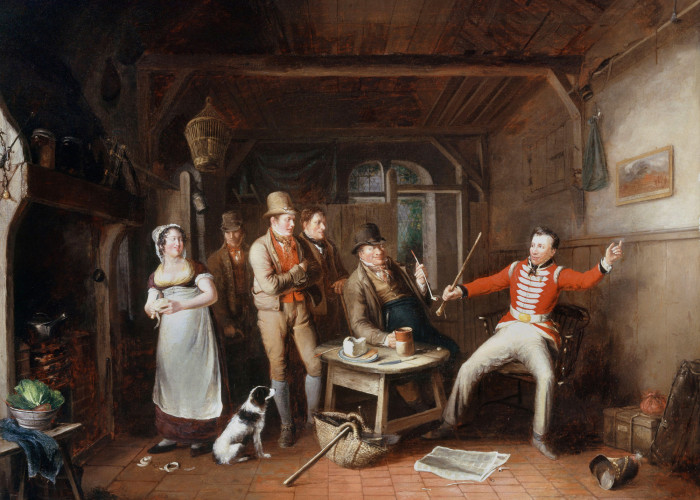A Soldier Recounting His Exploits in a Tavern
This painting by John Cawse, produced in 1821, just 6 years after the Battle of Waterloo, shows a soldier regaling a tavern full of people with stories of his adventures. From the medal of the soldier’s chest we know he is a “Waterloo Man”. On a variety of levels, Cawse’s painting shows how significant and interesting an event the Battle of Waterloo had become within British culture.
Painted six years after the battle, this is an example of narrative painting, an artistic style popular at the time. The painting as a whole tells a story, which is hinted at by a variety of clues, some obvious, some more subtle. Its original audience would have enjoyed hunting for these clues so as to fully understand what is going on in the scene.
The central figure is the soldier, readily identifiable as one of Wellington’s veterans. Unlike many of his comrades who had been discharged at the war’s end, this man is evidently still serving, as he retains his full uniform and has with him all his kit and accoutrements, which are stacked at the right of the scene. We know for certain that this is a Waterloo veteran, because he wears the Waterloo Medal pinned to the left breast of his scarlet coatee.
A newspaper lies discarded on the floor, suggesting that the soldier has taken exception to something within it that relates to the battle, and is giving the customers the benefit of his own account of how things were. This is illustrated with reference to a print of the battle, which is the only piece of decoration on the tavern wall.
Clearly he has his audience’s full attention. Even the dog is ignoring the food scraps on the floor and has turned to look at the soldier. Their faces convey a variety of responses, however. The seated gentleman, perhaps the publican, seems to be enjoying every word, but the two standing figures look more sceptical. The serving girl seems particularly taken by the tale of heroism, which is provoking a sour glance from the third standing figure in the background.
From a historical perspective, we have several indicators here of ongoing contemporary interest in Waterloo. The painting itself is focused on a Waterloo veteran, who in turn references a painting-within-a-painting, depicting the battle. The fact that he has the room’s full attention reinforces the importance of the events he is describing. However, the fact that not everyone is enrapt by his tale reinforces the ambiguous place of the ordinary soldier in the society of the day.
-
Curatorial info
- Originating Museum: National Army Museum
- Accession Number: NAM. 1992-03-1
- Production Date: 1821
- Creator: John Cawse
- Technique: Oil painting
- Size: Height 721mm x width 845mm
-
Use this image
You can download and use the high resolution image for use in a non-profit environment such as a school or college, but please take note of the license type and rights holder information below
- Rights Holder: National Army Museum
- License Type: All Rights Reserved
Find it here
This object is in the collection of Somerset Military Museum







